Spatial Allocation Rationality Analysis of Medical Resources Based on Multi-Source Data: Case Study of Taiyuan, China
Abstract
:1. Introduction
2. Materials
2.1. Study Area
2.2. Data Sources and Data Pre-Processing
2.2.1. Medical Data
2.2.2. Population Data
2.2.3. Road Network Data
2.2.4. Dianping Data
2.2.5. Public Transportation Data
3. Methods
3.1. Technology Frame
3.2. Construction of Index System
3.3. Index Calculation
3.3.1. Medical Service Coverage Rate Index from Different Medical Orientations
3.3.2. Comprehensive Accessibility Index for Multiple Transportation Modes
- Improvement of the distance decay function.
- 2.
- Improvement of transportation modes.
- 3.
- Improvement of catchment size.
3.3.3. Equity Index of Medical Facilities
3.3.4. Supply and Demand Ratio Index of Medical Resources from the Perspective of Sudden Public Health Events
3.4. Index Weighting Methodology
- Normalization of the Indicators: The purpose of normalization is to remove the dimensions:
- 2.
- Calculation of the Proportion of Each Indicator for All Samples:
- 3.
- Calculation of the Information Entropy for Each Indicator:
- 4.
- Calculation of the Weights for Each Indicator:
4. Results
4.1. Analysis of Index Terms of the Evaluation Model of Rationality of Medical Resources Spatial Allocation
4.1.1. Analysis of Medical Service Coverage Rate Index from Different Medical Orientations
4.1.2. Analysis of Comprehensive Accessibility Index for Multiple Transportation Modes
4.1.3. Analysis of Equity Index of Medical Facilities
4.1.4. Analysis of Supply and Demand Ratio Index of Medical Resources from the Perspective of Sudden Public Health Events
4.2. Evaluation and Analysis of Rationality of Medical Resource Spatial Allocation
5. Discussion
6. Conclusions
Author Contributions
Funding
Institutional Review Board Statement
Informed Consent Statement
Data Availability Statement
Conflicts of Interest
References
- Xi, Y.; Ding, Y.; Cheng, Y.; Zhao, J.; Zhou, M.; Qin, S. Evaluation of the Medical Resource Allocation: Evidence from China. Healthcare 2023, 11, 829. [Google Scholar] [CrossRef] [PubMed]
- State Council of the People’s Republic of China. China Promotes the Downward Shift of the Center of Gravity of Medical Services and the Sinking of Resources—Further Promoting the Construction of National Medical Centers and Regional Medical Centers. Available online: https://www.gov.cn/zhengce/2023-03/23/content_5748063.htm (accessed on 29 October 2023). (In Chinese)
- Chen, Q.; Cheng, J.; Tu, J. Analysing the Global and Local Spatial Associations of Medical Resources across Wuhan City Using POI Data. BMC Health Serv. Res. 2023, 23, 96. [Google Scholar] [CrossRef] [PubMed]
- Xi, Y.; Ren, F.; Liang, S.; Zhang, J.; Lin, D.N. Spatial Analysis of the Distribution, Risk Factors and Access to Medical Resources of Patients with Hepatitis B in Shenzhen, China. Int. J. Environ. Res. Public Health 2014, 11, 11505–11527. [Google Scholar] [CrossRef] [PubMed]
- Xu, P.; Fang, L. Study on Geographical Distribution and Optimization of Medical Facilities in Lhasa. Hosp. Manag. Forum 2024, 41, 31–36. [Google Scholar]
- Otamendi, F.; García-Heredia, D. Isochrones as Indicators of the Influence of Traffic in Public Health: A Visual Simulation Application in Ávila, Spain. Int. J. Environ. Res. Public Health 2015, 12, 12556–12576. [Google Scholar] [CrossRef]
- Lee, E. Designing Service Coverage and Measuring Accessibility and Serviceability of Rural and Small Urban Ambulance Systems. Systems 2014, 2, 34–53. [Google Scholar] [CrossRef]
- Yang, W.; Chen, N.; Wang, H. On the Accessibility of Medical Facilities in the Central Area of Shanghai Using Improved 2SFCA. J. Spatio-Temporal Inf. 2020, 50, 75–79. [Google Scholar]
- Jin, H.; Lu, Y. Multi-Mode Huff-Based 2SFCA: Examining Geographical Accessibility to Food Outlets in Austin, Texas. ISPRS Int. J. Geo-Inf. 2022, 11, 579. [Google Scholar] [CrossRef]
- Wei, J.; Li, Y.; Zhou, L. Research on Emergency Medical Institution Location for Public Health Emergencies Considering Regional Epidemic Risk. J. Risk Disaster Crisis Res. 2023, 96–126. [Google Scholar]
- Fadahunsi, J.T.; Kufoniyi, O.; Babatimehin, O.I. Spatial Analysis of Distribution Patterns of Healthcare Facilities in Osun State, Nigeria. Univers. J. Public Health 2017, 5, 331–344. [Google Scholar]
- Han, J.; Jiang, W.; Shi, J.; Xin, S.; Peng, J.; Liu, H. A Method for Assessing the Fairness of Health Resource Allocation Based on Geographical Grid. Comput. Mater. Contin. 2020, 64, 1171–1184. [Google Scholar] [CrossRef]
- Yin, C.; He, Q.; Liu, Y.; Chen, W.; Gao, Y. Inequality of Public Health and Its Role in Spatial Accessibility to Medical Facilities in China. Appl. Geogr. 2018, 92, 50–62. [Google Scholar] [CrossRef]
- Liu, Z.; Zhang, N.; Cheng, Y. Spatial Equity and Efficiency of Medical Resource Allocation in Qinghai Province. Prog. Geogr. 2023, 42, 1891–1903. [Google Scholar] [CrossRef]
- Fu, R.; Zhang, X.; Yang, D. Spatial Equity of Healthcare Resource in Xinjiang. J. Univ. Chin. Acad. Sci. 2023, 40, 69–78. [Google Scholar]
- Tian, D.; Wang, J.; Xia, C.; Zhang, J.; Zhou, J.; Tian, Z.; Zhao, J.; Li, B.; Zhou, C. The Relationship between Green Space Accessibility by Multiple Travel Modes and Housing Prices: A Case Study of Beijing. Cities 2024, 145, 104694. [Google Scholar] [CrossRef]
- Wear, D.; Zarconi, J.; Aultman, J.M.; Chyatte, M.R.; Kumagai, A.K. Remembering Freddie Gray: Medical Education for Social Justice. Acad. Med. 2017, 92, 312–317. [Google Scholar] [CrossRef] [PubMed]
- Emanuel, E.J.; Persad, G.; Upshur, R.; Thome, B.; Parker, M.; Glickman, A.; Zhang, C.; Boyle, C.; Smith, M.; Phillips, J.P. Fair Allocation of Scarce Medical Resources in the Time of COVID-19. N. Engl. J. Med. 2020, 382, 2049–2055, ISSN 0028-4793. [Google Scholar] [CrossRef] [PubMed]
- Schwanke Khilji, S.U.; Rudge, J.W.; Drake, T.; Chavez, I.; Borin, K.; Touch, S.; Coker, R. Distribution of Selected Healthcare Resources for Influenza Pandemic Response in Cambodia. Int. J. Equity Health 2013, 12, 82. [Google Scholar] [CrossRef] [PubMed]
- Wu, J.; Fu, J.; Wang, H.; Zhao, Y.; Yi, T. Identifying Spatial Matching between the Supply and Demand of Medical Resource and Accessing Carrying Capacity: A Case Study of Shenzhen, China. Int. J. Environ. Res. Public Health 2022, 19, 2354. [Google Scholar] [CrossRef]
- Yu, Y.; Zhou, R.; Qian, L.; Yang, X.; Dong, L.; Zhang, G. Supply-Demand Balance and Spatial Distribution Optimization of Primary Care Facilities in Highland Cities from a Resilience Perspective: A Study of Lhasa, China. Front. Public Health 2023, 11, 1131895. [Google Scholar] [CrossRef]
- Sun, K.; Cai, Y.; Lin, S.; Wang, S.; Wang, C. Research on the Elastic Development of Spatial Layout of Hospitals Based on GIS Platform under COVID-19 Background: A Case Study of Wuhan. In Proceedings of the International Conference on Construction and Real Estate Management, ICCREM 2021, Beijing, China, 16–17 October 2021. [Google Scholar]
- Cheng, G.; Zeng, X.; Duan, L.; Lu, X.; Sun, H.; Jiang, T.; Li, Y. Spatial Difference Analysis for Accessibility to High Level Hospitals Based on Travel Time in Shenzhen, China. Habitat Int. 2016, 53, 485–494. [Google Scholar] [CrossRef]
- Liu, D.; Li, L. Application Study of Comprehensive Forecasting Model Based on Entropy Weighting Method on Trend of PM2. 5 Concentration in Guangzhou, China. Int. J. Environ. Res. Public Health 2015, 12, 7085–7099. [Google Scholar] [CrossRef]
- Malekinezhad, H.; Sepehri, M.; Pham, Q.B.; Hosseini, S.Z.; Meshram, S.G.; Vojtek, M.; Vojteková, J. Application of Entropy Weighting Method for Urban Flood Hazard Mapping. Acta Geophys. 2021, 69, 841–854. [Google Scholar] [CrossRef]
- Zhu, Y.; Tian, D.; Yan, F. Effectiveness of Entropy Weight Method in Decision-Making. Math. Probl. Eng. 2020, 2020, 3564835. [Google Scholar] [CrossRef]
- Jiao, H.; Li, J.; Liu, L.; Zhao, H. Study on the Rationalization of Human Resources Allocation in Hospitals in the Post-Epidemic Era. Appl. Math. Nonlinear Sci. 2024, 9. [Google Scholar] [CrossRef]
- Song, G.; He, X.; Kong, Y.; Li, K.; Song, H.; Zhai, S.; Luo, J. Improving the Spatial Accessibility of Community-Level Healthcare Service toward the ‘15-Minute City’ Goal in China. ISPRS Int. J. Geo-Inf. 2022, 11, 436. [Google Scholar] [CrossRef]
- Vallée, J.; Shareck, M.; Le Roux, G.; Kestens, Y.; Frohlich, K.L. Is Accessibility in the Eye of the Beholder? Social Inequalities in Spatial Accessibility to Health-Related Resources in Montréal, Canada. Soc. Sci. Med. 2020, 245, 112702. [Google Scholar] [CrossRef]
- Pearce, J.; Witten, K.; Bartie, P. Neighbourhoods and Health: A GIS Approach to Measuring Community Resource Accessibility. J. Epidemiol. Community Health 2006, 60, 389–395. [Google Scholar] [CrossRef]
- Kim, Y.; Byon, Y.-J.; Yeo, H. Enhancing Healthcare Accessibility Measurements Using GIS: A Case Study in Seoul, Korea. PLoS ONE 2018, 13, e0193013. [Google Scholar] [CrossRef]
- CJJ 37-2012 (CJJ37-2012); Code for Design of Urban Road Engineering. China Architecture & Building Press: Beijing, China, 2012.
- Chen, J.; Huang, Q.; Chen, Z.; Wan, Y. Travel Mode Recognition Based on Personal Trajectory Data. Land Resour. Her. 2020, 17, 56–64. [Google Scholar]
- Fonarow, G.C.; Smith, E.E.; Reeves, M.J.; Pan, W.; Olson, D.; Hernandez, A.F.; Peterson, E.D.; Schwamm, L.H.; Get with the Guidelines Steering Committee and Hospitals. Hospital-Level Variation in Mortality and Rehospitalization for Medicare Beneficiaries with Acute Ischemic Stroke. Stroke 2011, 42, 159–166. [Google Scholar] [CrossRef] [PubMed]
- Du, Z.; Liao, Y.; Chen, C.-C.; Hao, Y.; Hu, R. Usual Source of Care and the Quality of Primary Care: A Survey of Patients in Guangdong Province, China. Int. J. Equity Health 2015, 14, 60. [Google Scholar] [CrossRef] [PubMed]
- Hoa, N.T.; Tam, N.M.; Derese, A.; Markuns, J.F.; Peersman, W. Patient Experiences of Primary Care Quality amongst Different Types of Health Care Facilities in Central Vietnam. BMC Health Serv. Res. 2019, 19, 275. [Google Scholar] [CrossRef]
- Wang, W.; Maitland, E.; Nicholas, S.; Loban, E.; Haggerty, J. Comparison of Patient Perceived Primary Care Quality in Public Clinics, Public Hospitals and Private Clinics in Rural China. Int. J. Equity Health 2017, 16, 176. [Google Scholar] [CrossRef] [PubMed]
- Tian, D.; Zhang, J.; Li, B.; Xia, C.; Zhu, Y.; Zhou, C.; Wang, Y.; Liu, X.; Yang, M. Spatial Analysis of Commuting Carbon Emissions in Main Urban Area of Beijing: A GPS Trajectory-Based Approach. Ecol. Indic. 2024, 159, 111610. [Google Scholar] [CrossRef]
- Paul, J.; Edwards, E. Temporal Availability of Public Health Care in Developing Countries of the Caribbean: An Improved Two-step Floating Catchment Area Method for Estimating Spatial Accessibility to Health Care. Int. J. Health Plan. Manag. 2019, 34, e536–e556. [Google Scholar] [CrossRef] [PubMed]
- Chen, P.; Jian, I.; Zhang, L.; Siu, K.W.M.; Liu, J.; Liu, Z.; Chen, X.-J. Towards a Smart Healthy City: A Generalised Flow-Based 2SFCA Method for Incorporating Actual Mobility Data in Healthcare Accessibility Evaluation. Travel Behav. Soc. 2024, 34, 100706. [Google Scholar] [CrossRef]
- Su, H.; Chen, W.; Cheng, M. Using the Variable Two-Step Floating Catchment Area Method to Measure the Potential Spatial Accessibility of Urban Emergency Shelters. GeoJournal 2022, 87, 2625–2639. [Google Scholar] [CrossRef]
- Wang, H.; Wei, X.; Ao, W. Assessing Park Accessibility Based on a Dynamic Huff Two-Step Floating Catchment Area Method and Map Service API. ISPRS Int. J. Geo-Inf. 2022, 11, 394. [Google Scholar] [CrossRef]
- Du, M.; Cheng, L.; Li, X.; Yang, J. Factors Affecting the Travel Mode Choice of the Urban Elderly in Healthcare Activity: Comparison between Core Area and Suburban Area. Sustain. Cities Soc. 2020, 52, 101868. [Google Scholar] [CrossRef]
- Zhou, M. Equity and Prediction of Health Resource Allocation of Traditional Chinese Medicine in China. PLoS ONE 2023, 18, e0290440. [Google Scholar] [CrossRef] [PubMed]
- Zhou, M. Human Resources Allocation of the Centers for Disease Control and Prevention in China. Risk Manag. Healthc. Policy 2024, 17, 341–353. [Google Scholar] [CrossRef] [PubMed]
- State Council of the People’s Republic of China. Guidance Principles for the Planning of Medical Institutions (2021–2025). Available online: https://www.gov.cn/zhengce/zhengceku/2022-02/01/content_5671603.htm (accessed on 30 October 2023). (In Chinese)
- Kang, J.-Y.; Michels, A.; Lyu, F.; Wang, S.; Agbodo, N.; Freeman, V.L.; Wang, S. Rapidly Measuring Spatial Accessibility of COVID-19 Healthcare Resources: A Case Study of Illinois, USA. Int. J. Health Geogr. 2020, 19, 36. [Google Scholar] [CrossRef]
- Tuczyńska, M.; Matthews-Kozanecka, M.; Baum, E. Accessibility to Non-COVID Health Services in the World during the COVID-19 Pandemic. Front. Public Health 2021, 9, 760795. [Google Scholar] [CrossRef] [PubMed]
- Huang, J. Combining Entropy Weight and TOPSIS Method for Information System Selection. In Proceedings of the 2008 IEEE Conference on Cybernetics and Intelligent Systems, Chengdu, China, 21–24 September 2008; IEEE: Piscataway, NJ, USA, 2008; pp. 1281–1284. [Google Scholar]
- Department of Commerce of Shanxi Province. Implementation Plan for the Pilot Project of Promoting the Construction of Urban 15-Minute Convenient Living Circle in Shanxi Province (2022–2024). Available online: https://swt.shanxi.gov.cn/xxgk/xxgkzl/xxgklm/gztz_69874/202206/t20220629_6514035.shtml (accessed on 13 November 2023). (In Chinese)
- Nie, Y.; Feng, C. Research on Accessibility of Medical Treatment Based on Grading Treatment: A Case Study of Weifang City Center Area. Beijing Da Xue Xue Bao 2020, 56, 307–314. [Google Scholar]
- Lane, H.; Sarkies, M.; Martin, J.; Haines, T. Equity in Healthcare Resource Allocation Decision Making: A Systematic Review. Soc. Sci. Med. 2017, 175, 11–27. [Google Scholar] [CrossRef]
- Li, X.; Kawamura, K. Methodology for Real-Time Evaluation of Geographic Health Care Resource Allocation: Iwate Prefectural Hospitals. Sci. J. Bus. Manag. 2021, 9, 55. [Google Scholar] [CrossRef]
- Mao, K.; Li, J.; Yan, H. Measuring the Spatial Accessibility of Parks in Wuhan, China, Using a Comprehensive Multimodal 2SFCA Method. ISPRS Int. J. Geo-Inf. 2023, 12, 357. [Google Scholar] [CrossRef]
- Wu, X.; Mao, R.; Guo, X. Equilibrium of Tiered Healthcare Resources during the COVID-19 Pandemic in China: A Case Study of Taiyuan, Shanxi Province. Int. J. Environ. Res. Public Health 2022, 19, 7035. [Google Scholar] [CrossRef]
- Wu, X.; Zhang, Y.; Guo, X. Research on the Equity and Influencing Factors of Medical and Health Resources Allocation in the Context of COVID-19: A Case of Taiyuan, China. Healthcare 2022, 10, 1319. [Google Scholar] [CrossRef]
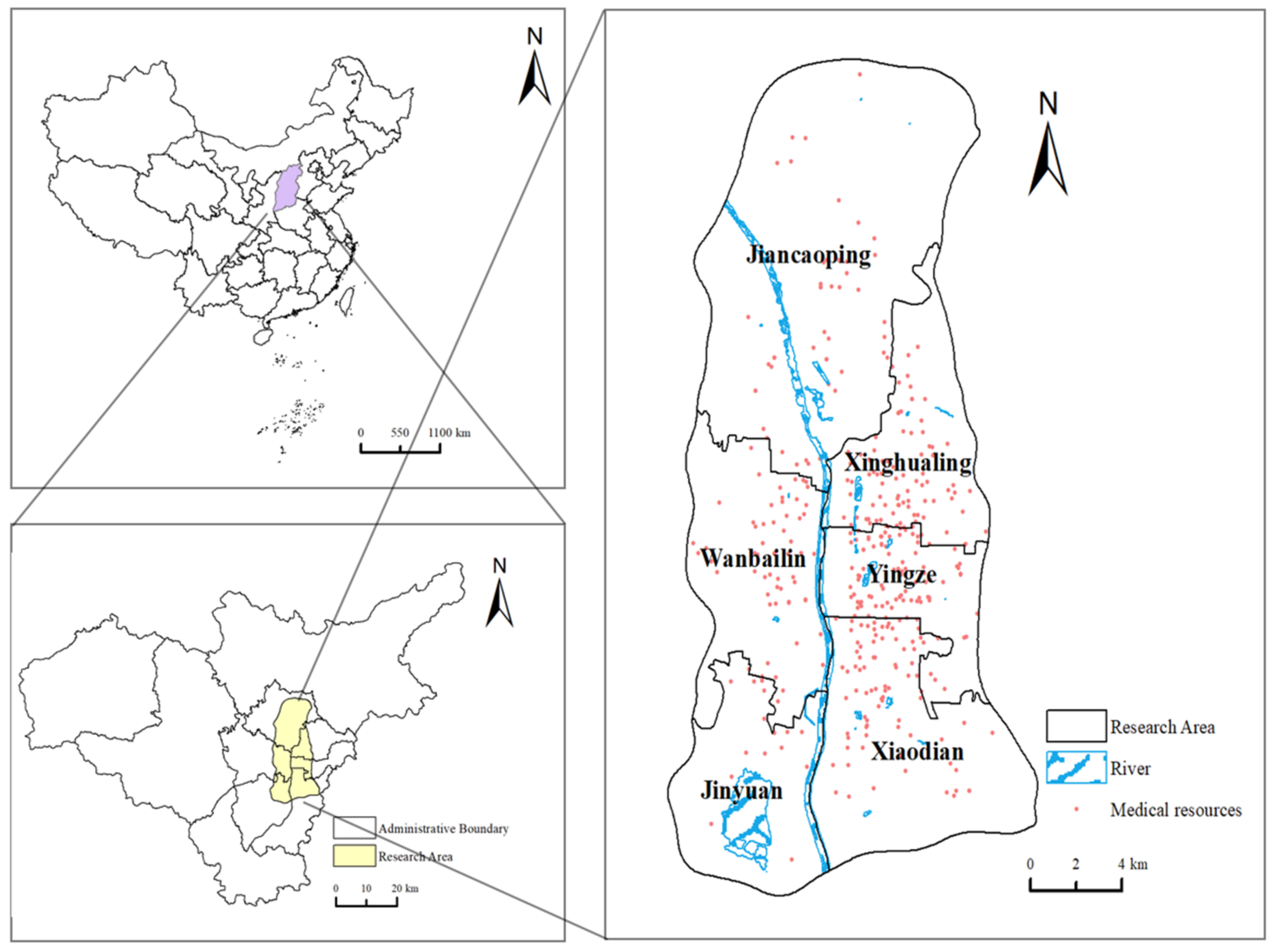
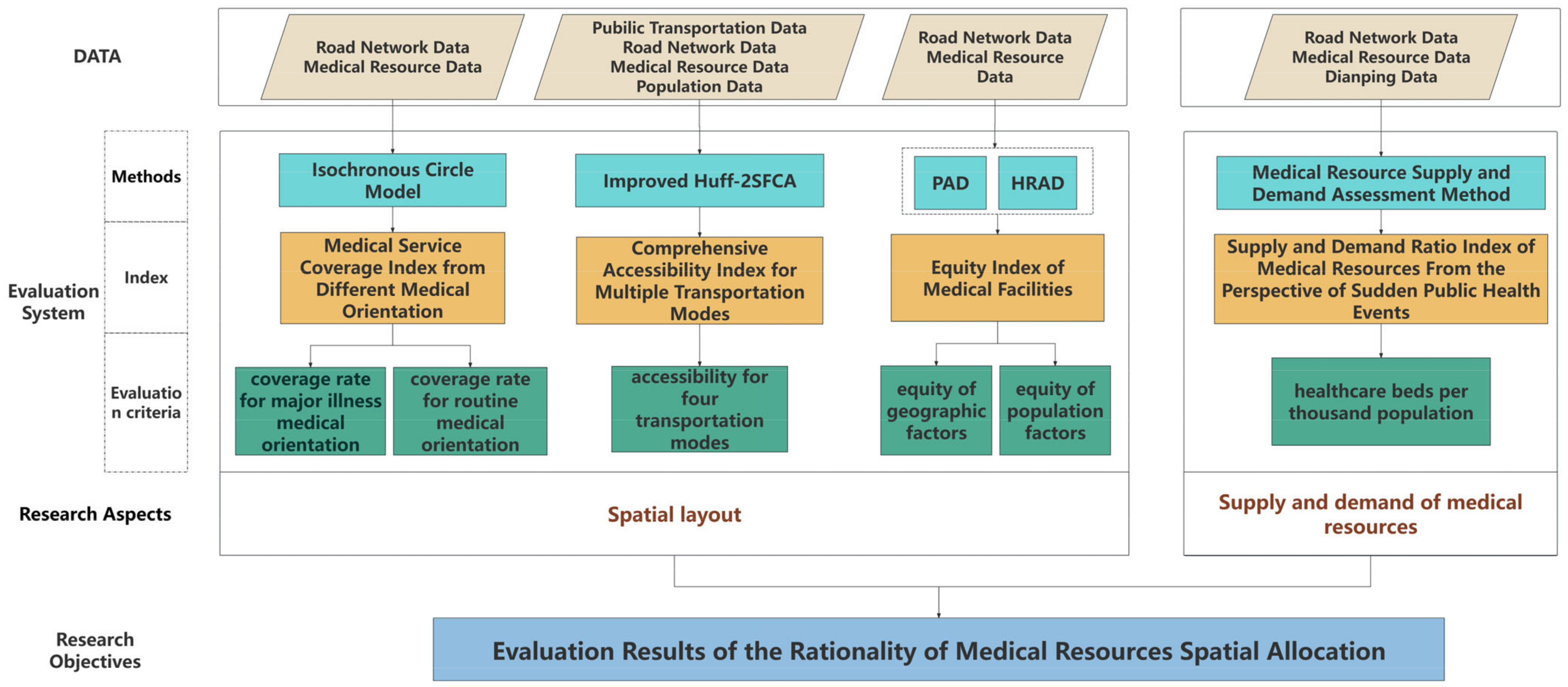
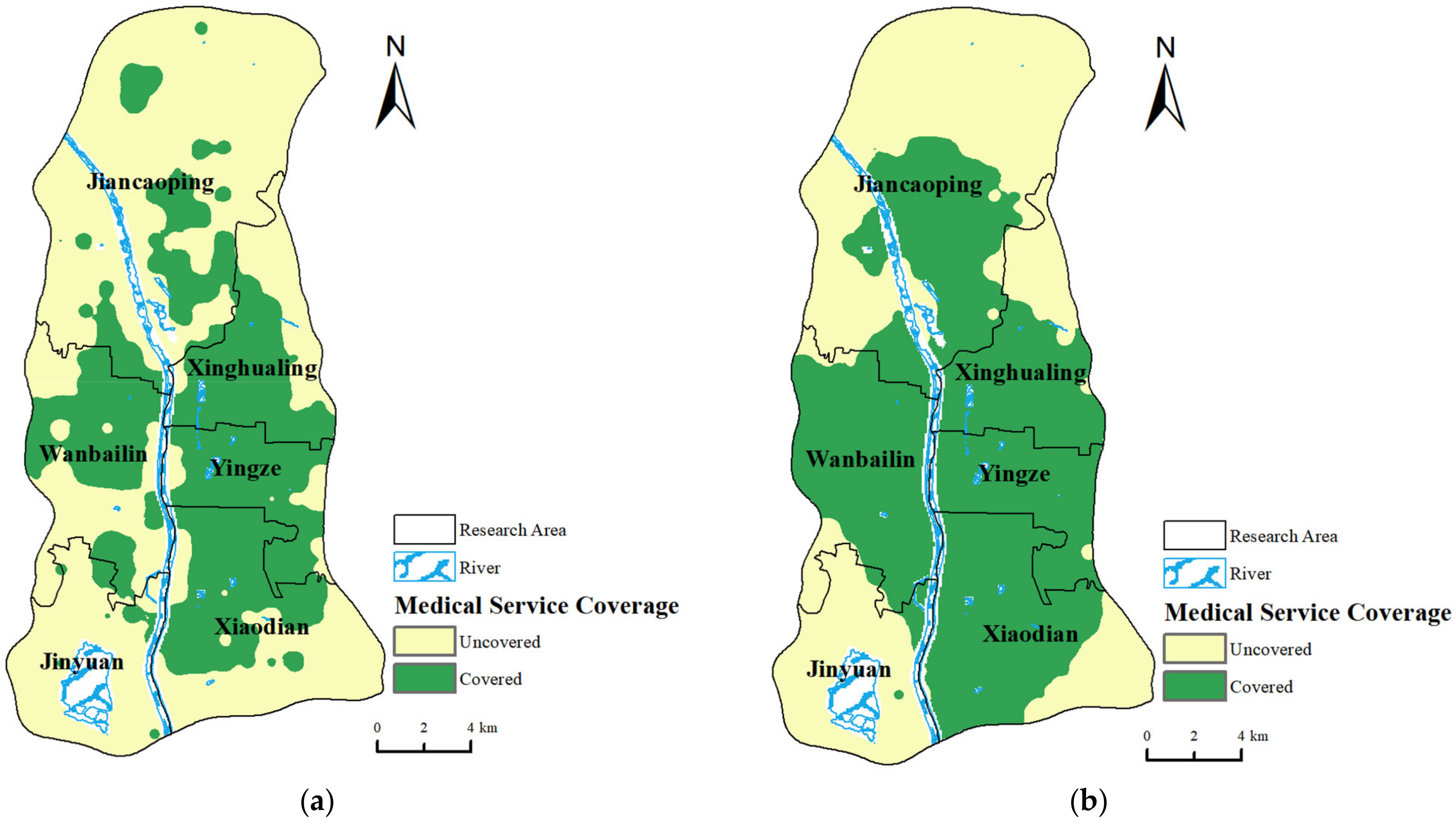
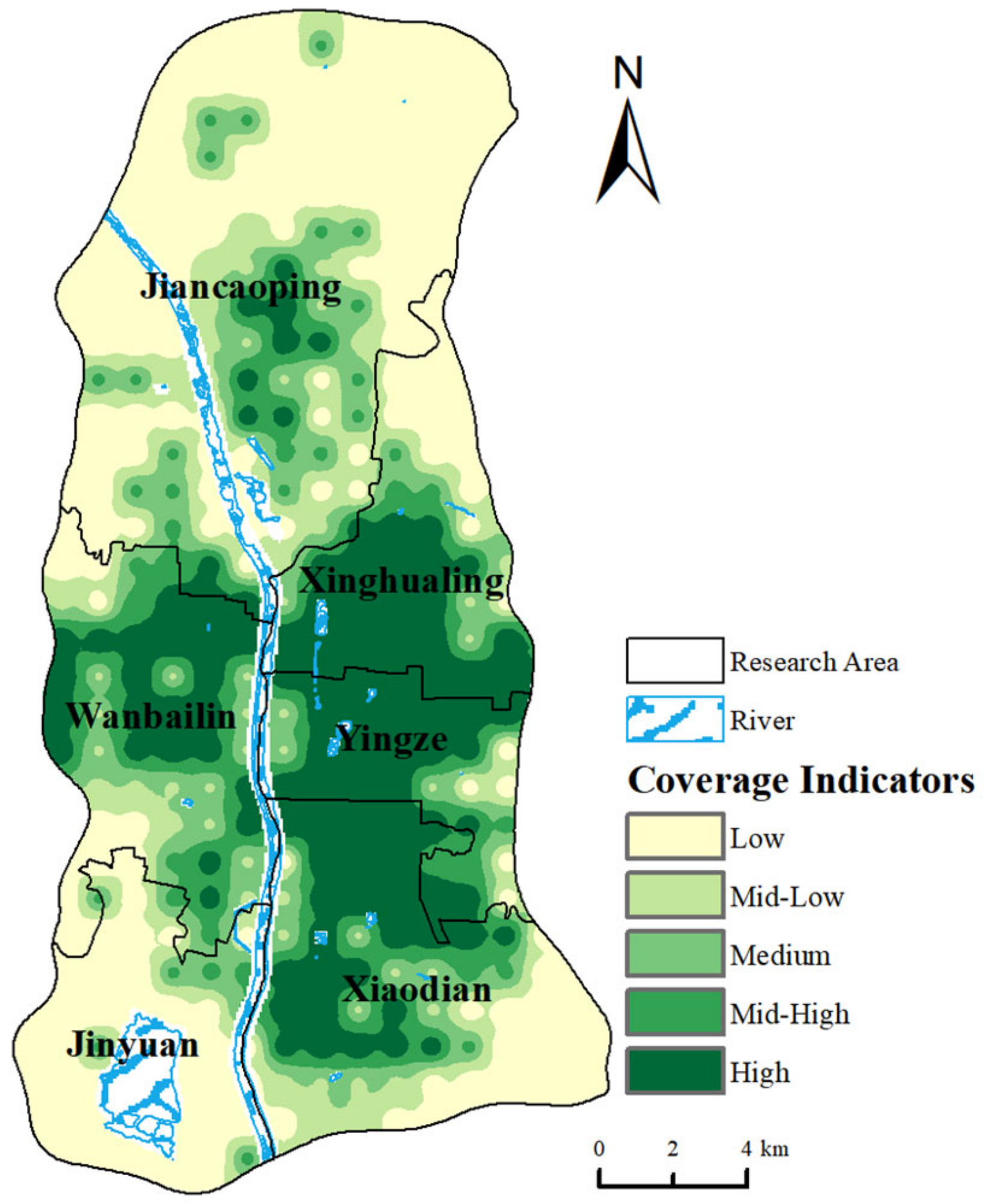
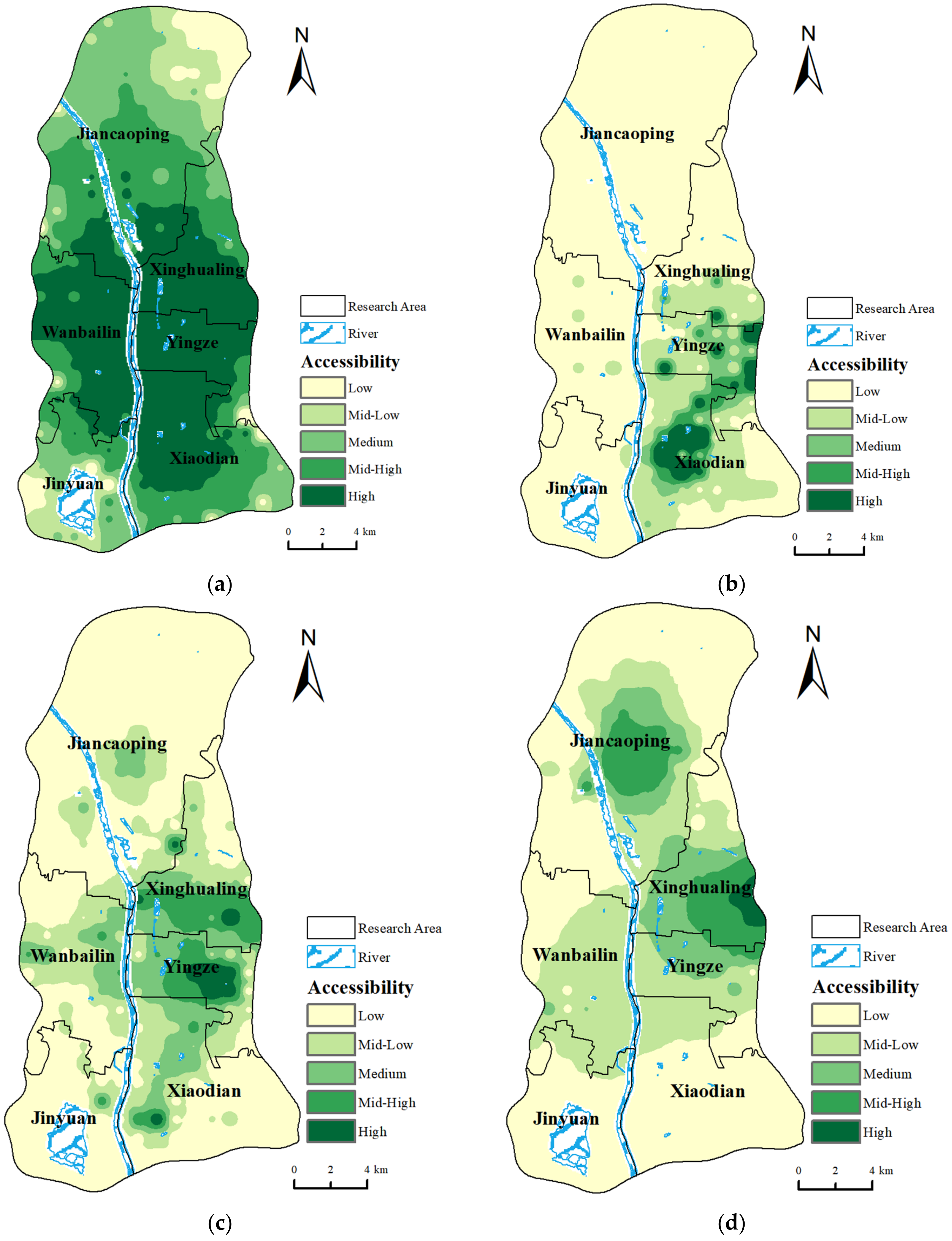
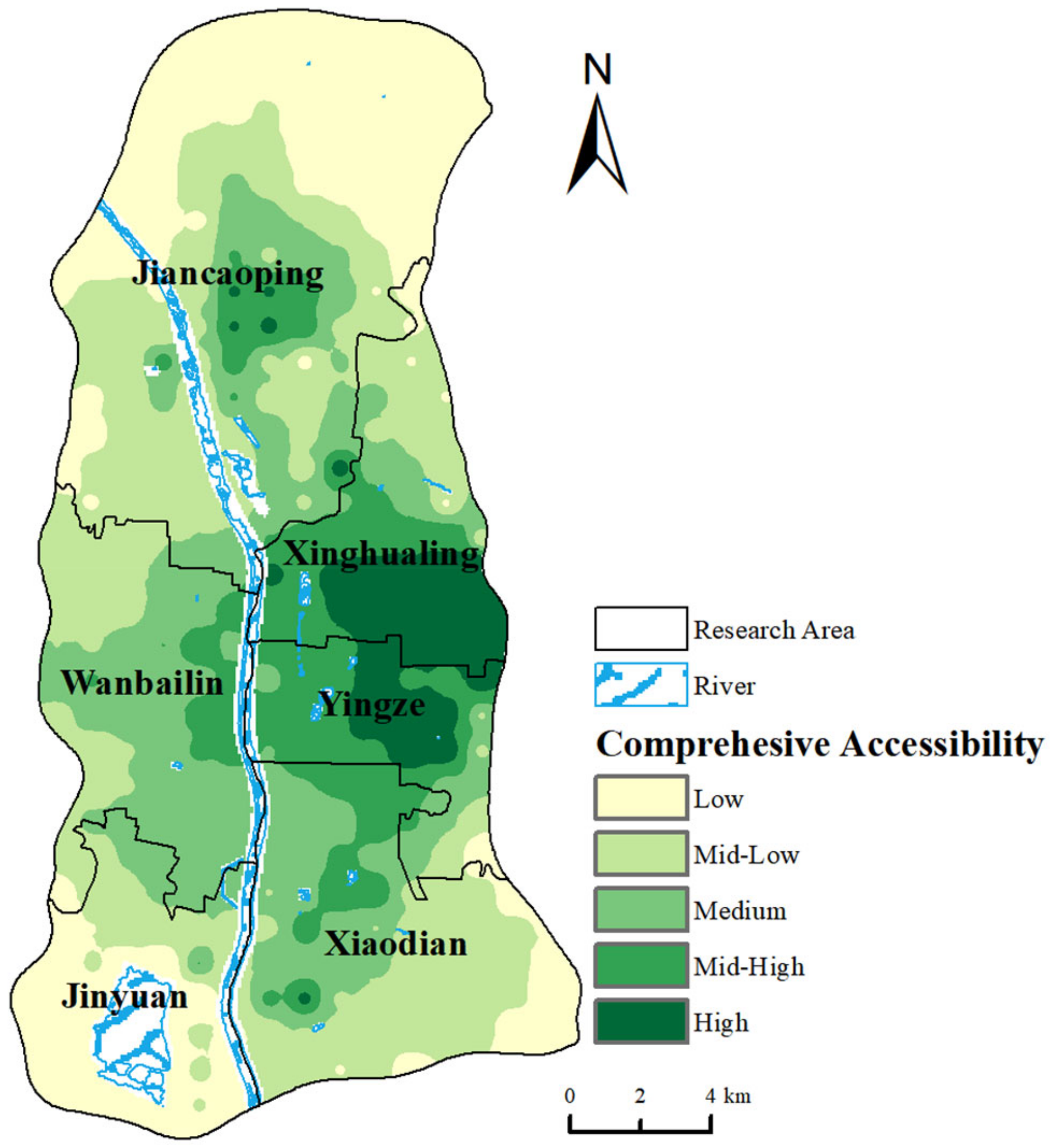
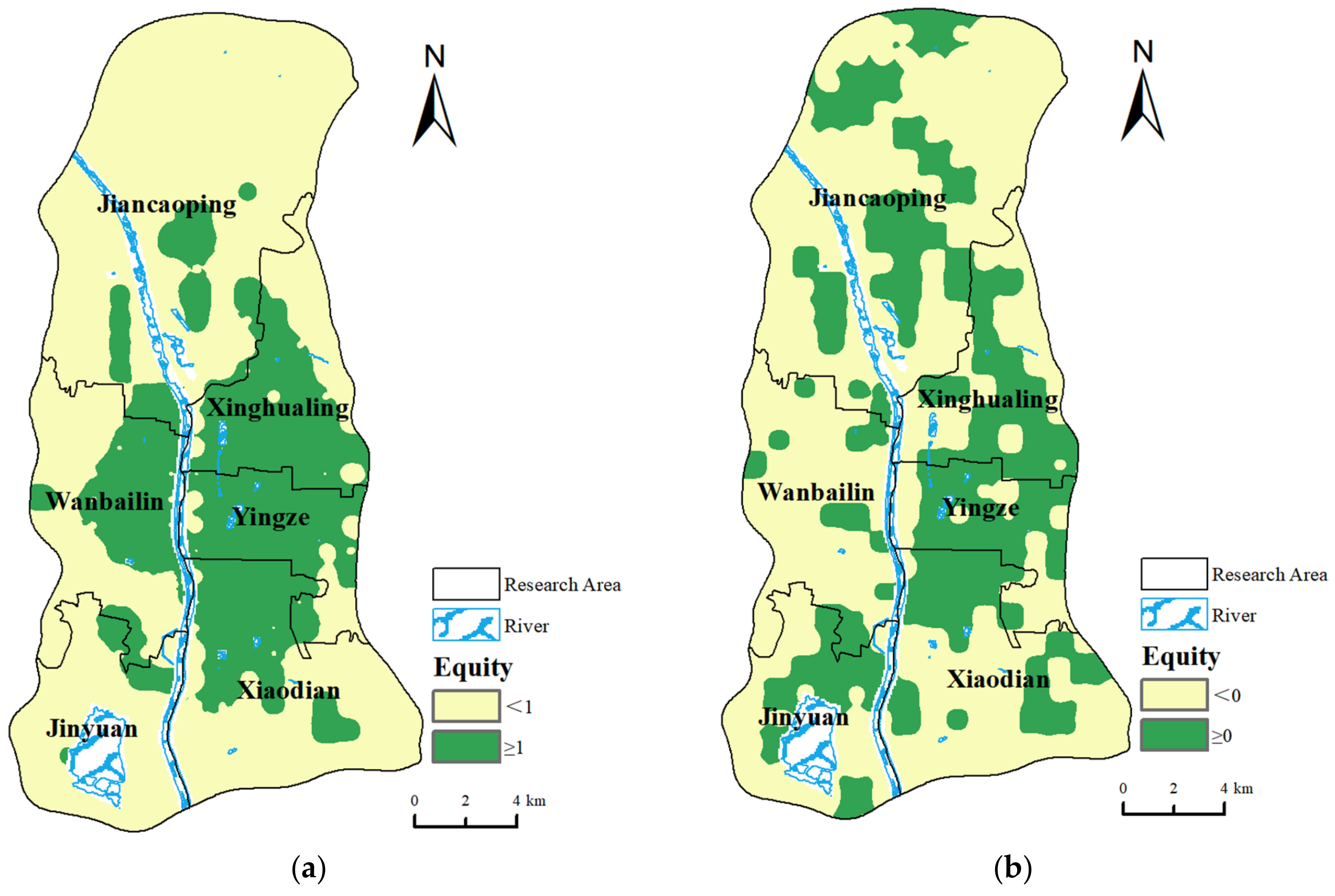
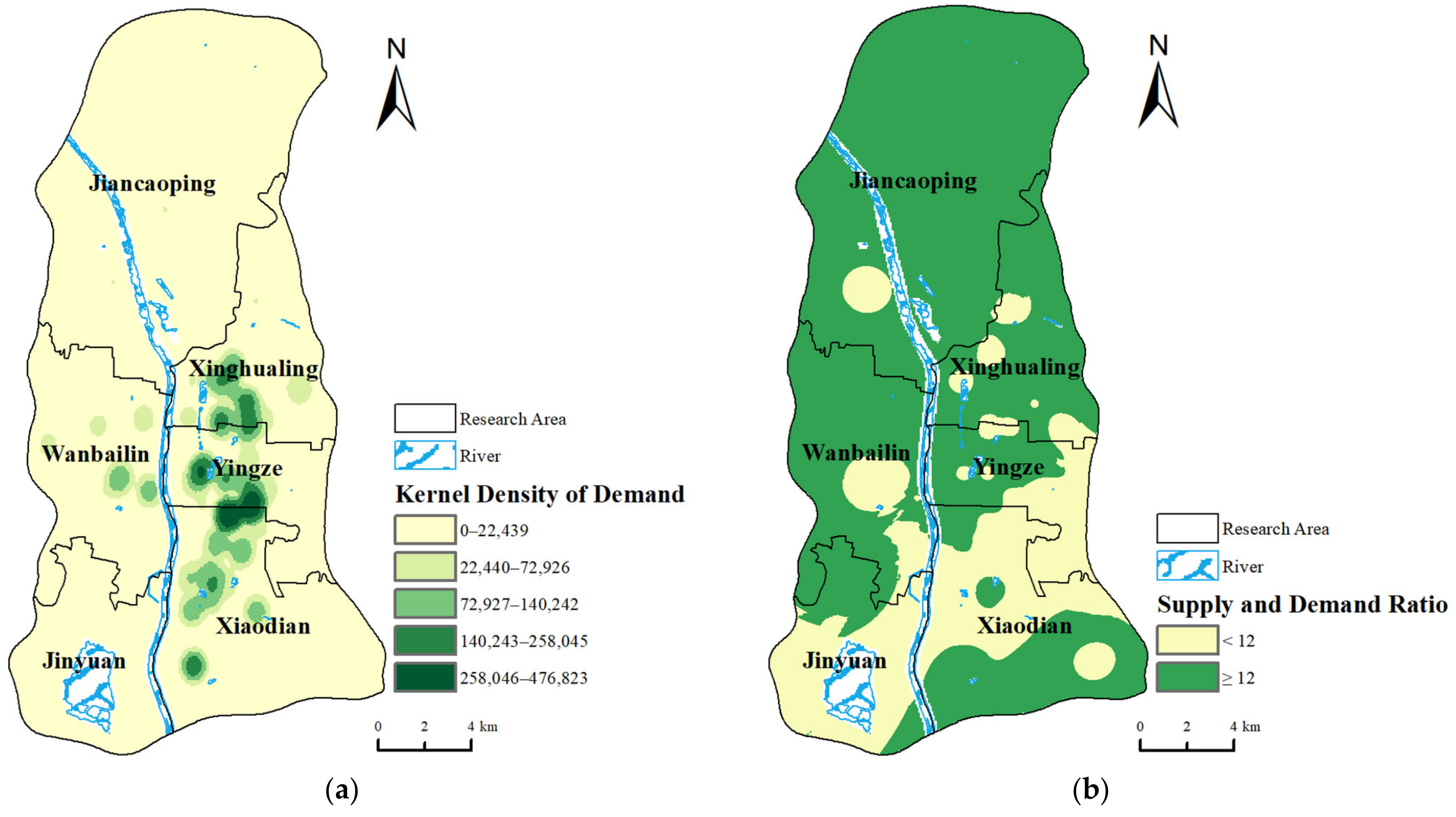
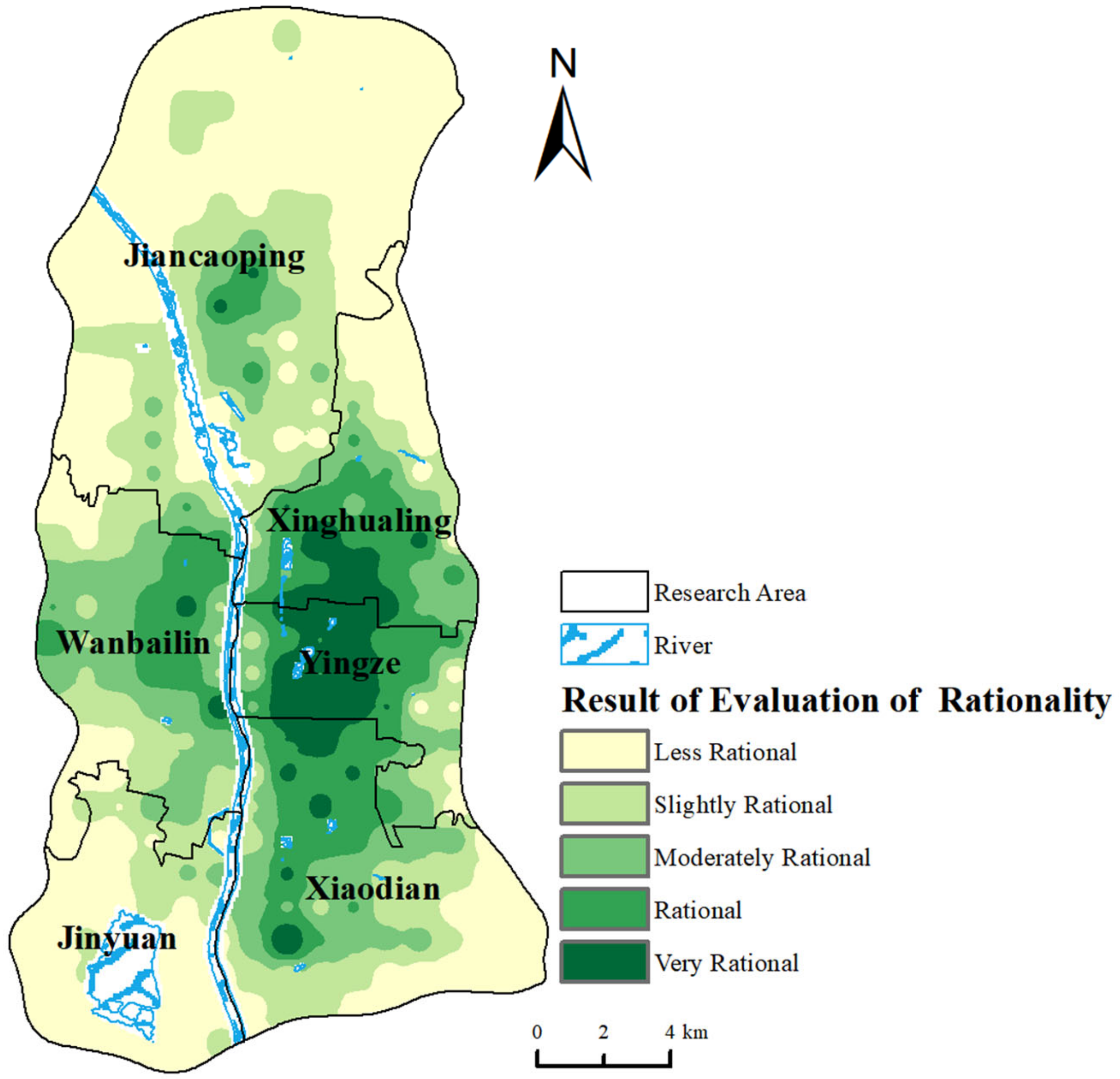
| Road Class | Expressway | Trunk Road | Secondary Road | Spur Road |
|---|---|---|---|---|
| Speed of design (km/h) | 80 | 50 | 40 | 20 |
| Objective Layer | Criterion Layer | Overall Indicator Layer | Description |
|---|---|---|---|
| Evaluation Model Index System for the Rationality of Medical Resources Spatial Allocation | Spatial Layout | 1. Medical Service Coverage Rate Index from Different Medical Orientations ) | Calculate the service coverage rates of various levels of medical institutions based on the behavior patterns of residents choosing corresponding medical institutions under different disease conditions |
| 2. Comprehensive Accessibility Index for Multiple Transportation Modes ) | Quantify the convenience of residents obtaining medical services through different modes of transportation, including driving, walking, bus, and cycling | ||
| 3. Equity Index of Medical Facilities ) | Describe whether the distribution of medical resources and services is equitable among different population groups and geographic regions | ||
| Supply and Demand of Medical Resources | 4. Supply and Demand Ratio Index of Medical Resources From the Perspective of Sudden Public Health Events ) | Assess whether medical resources can meet medical demands during sudden medical events |
| Time (min) | 0–15 | 15–30 | 30–45 | 45–60 | >60 | ||
|---|---|---|---|---|---|---|---|
| Walking | Major illness medical orientations ) | Percentage of residential points | 6.61% | 20.11% | 15.43% | 13.77% | 44.08% |
| Percentage of area | 4.33% | 21.32% | 16.15% | 14.20% | 44.00% | ||
| Routine medical orientations ) | Percentage of residential points | 39.67% | 29.75% | 16.53% | 7.16% | 6.89% | |
| Percentage of area | 37.64% | 36.08% | 15.21% | 6.78% | 4.29% | ||
| Overall Indicators | Secondary Indicators | Information Entropy (d) | Weights ) |
|---|---|---|---|
| Medical Service Coverage Rate Index from Different Medical Orientations ) | 0.880714 | 18.54% | |
| Comprehensive Accessibility Index for Multiple Transportation Modes ) | 0.977458 | 3.50% | |
| Equity Index of Medical Facilities | Geographic factors ) | 0.810196 | 29.50% |
| Population factors ) | 0.993955 | 0.94% | |
| Supply and Demand Ratio Index of Medical Resources From the Perspective of Sudden Public Health Events ) | 0.694190 | 47.52% |
| Rationality Rating | Score | Percentage of Regional Area |
|---|---|---|
| Less rational | 0–0.06 | 38.73% |
| Slightly rational | 0.07–0.14 | 22.40% |
| Moderately rational | 0.15–0.24 | 18.95% |
| Rational | 0.25–0.36 | 14.24% |
| Very rational | 0.37–0.71 | 5.68% |
Disclaimer/Publisher’s Note: The statements, opinions and data contained in all publications are solely those of the individual author(s) and contributor(s) and not of MDPI and/or the editor(s). MDPI and/or the editor(s) disclaim responsibility for any injury to people or property resulting from any ideas, methods, instructions or products referred to in the content. |
© 2024 by the authors. Licensee MDPI, Basel, Switzerland. This article is an open access article distributed under the terms and conditions of the Creative Commons Attribution (CC BY) license (https://creativecommons.org/licenses/by/4.0/).
Share and Cite
Hu, L.; Cai, S. Spatial Allocation Rationality Analysis of Medical Resources Based on Multi-Source Data: Case Study of Taiyuan, China. Healthcare 2024, 12, 1669. https://doi.org/10.3390/healthcare12161669
Hu L, Cai S. Spatial Allocation Rationality Analysis of Medical Resources Based on Multi-Source Data: Case Study of Taiyuan, China. Healthcare. 2024; 12(16):1669. https://doi.org/10.3390/healthcare12161669
Chicago/Turabian StyleHu, Lujin, and Shengqi Cai. 2024. "Spatial Allocation Rationality Analysis of Medical Resources Based on Multi-Source Data: Case Study of Taiyuan, China" Healthcare 12, no. 16: 1669. https://doi.org/10.3390/healthcare12161669







